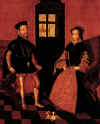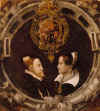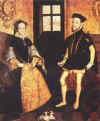
Mary and her husband Felipe of Spain
Oil on canvas English School, 17th century
National Maritime Museum, Greenwich

Mary and Felipe

Mary and Felipe of Spain
by Mor
At Woburn Abbey
THE MARRIAGE OF QUEEN MARY AND KING FELIPE.
This is the official account recorded by the English heralds. I have not been able to discover the original or contemporary manuscript; but there are several copies of it both at the College of Arms and the British Museum, some of them less complete from abridgment. It was printed at the end of Leland's Collectanea, edit. 1774, vol. ii. "Copied out of a book of presidents collected by Ralph Brooke, York herauld, now remaining with sir Edward Dering; examined this 28th of Feb. 1634, by us, William Le Neve, Norroy, and Edward Whitley."

Mary and her husband Felipe of Spain |

Mary and Felipe |

Mary and Felipe of Spain |
The marriage of Queen Mary and Phillip prince of Spain, son to Charles the Fifth, emperor; in the cathedrall church of Winchester, on wensday 25th Jul, 1554.
First, the said church was richly hanged with arras and cloth of gold, and in the midst of the church, from the west door unto the rood, was a scaffold erected of timber, at the end whereof was raised a mount, covered all with red say, and underneath the roode-loft were erected two traverses, one for the Queen on the right hand, and the other for the prince on the left, which places served very well for the purpose. The quire was allso richly hanged with cloth of gold, and on each side of the altar were other two rich traverses as aforesaid, for the queenes majestie and prince.
The Queen made her entry into the city of Winchester very richly in apparell, on saturday the 21st of Jul, and was lodged in the bishop's palace, and prince Phillip made his entry into the said city on munday after, being the 23d of Jul; at whose entry the mayor delivered him the keys of the city, which he received, and delivered them back again, being lodged at the dean's house.
On wensday the 25th of Jul, being St. James's day, the prince, richly apparelled in cloth of gold, embroidered, [1] with a great company of the nobles of Spayne, in such sort as the like hath not been seen, proceded to the church, and entered in at the west door, and passed to his traverse, all the way on foot; and to the church he had no sword borne before him.
Then came the queenes majesty, accompanied with a great number of the nobility of the realm, the sword being borne before her by the Earl of Derby, and a great company of ladyes and gentlewomen very richly apparelled; her majesty's train was borne up by the marquesse of Winchester, [2] assisted by sir John Gage her lord chamberlayne; and so she pro ceeded to the church; the kinges and herauldes of arms in their coates going before her from her lodgiDg on foot to the church, where entering at the west door she passed on till she came to her traverse. Then the Stephen Gardiner, Bishop of Winchester, lord chancellor of England, which did the divine service, assisted by the bishopes of London, Duresme, Chichester, Lyncoln, and Ely, all with their crosiers borne before them, came out of the quier to the mount.
Then came the regent Figirola, whose name was (blank), and presented to the prince a solemn oration with a patent sent from the Emperor to the prince, of the surrender of the kingdom of Naples, freely given to him and his heirs, as by the said patent was declared; which patent was fair sealed and inclosed in a cover of silver gilt. This done, the lord chamberlayn [3] made a goodly oration to the people, which was in effect as followeth: Whereas the Emperor, by his embassadors here in England, hath concluded and contracted a marriage between the Queen's majesty and his chief jewell and son and heir Phillip prince of Spain, here present, the articles whereof are not unknowen to tbe whole realme, and confirmed by act of parliament, so that there needeth no further rehearsall of that matter, &c. and so like wise declared that the queenes highness had sent the Earl of Bedford and the lord Fitzwater embassadores unto the realme of Spain, for the performing of the said contract, which they have here brought, with the consent of the whole realme of Spayne, for the full conclusion of the same, as may appear by this instrument in parchment, sealed with a great seal, containing by estimation 12 leaves.
Then the lord chamberlayn [4] delivered openly for the solemnification of their highness' marriage, how that the Emperor had given unto his son the kingdom of Naples. So that it was thought the Queen's majesty should marry but with a prince, now it was manifested that she should marry with a King; and so proceeded to the espousals; and with a loud voice said that, if there be any man that knoweth any lawful impediment between these two parties, that they should not go together according to the contract concluded between both realmes, that then they should come forth, and they should be heard; or else to proceed to celebration of the said marriage, which was pronounced in English and Latin; and when it came to the gift of the Queen it was asked who should give her. Then the marquess of Winchester, the earles of Derby, Bedford, and Pembroke, gave her highness, in the name of the whole realm.
Then all the people gave a great shout, praying God to send them joy; and, the ring being laid upon the book to be hallowed, the prince laid also upon the said book iij. hand-fulls of fine gold; which the lady Margaret [5] seeing, opened the Queen's purse, and the Queen smilingly put up in the same purse. And when they had inclosed their hands, immediately the sword was advanced before the King, by the Earl of Pembroke.
This done, the trumpetes sounded; and thus both returned hand in hand, the sword being borne before them, to their traverses in the quier, the Queen going always on the right hand, and there remained until mass was done; at which time wine and sops were hallowed, and gave unto them; and immediately after, Garter King of arms, with the other kinges and herauldes, published and proclaimed their titles in Latin, French, and English; and so they returned to the bishop's palace both under one canopy, born by vij. knightes, the Queen on the right hand, and their swordes borne before them; and so proceeded to the hall, where they both dined under one cloth of estate.

Of the marriage banquet the narrative of Edward Underhill supplies some account: [6]
"On the maryage daye, the kynge and the quene dyned in the halle in the bushop's palice, sittynge under the clothe of estate, and none eles att that table. The nobillitie satte att the syde tables. Wee [7] weare the cheffe sarveters, to cary the meate, and the yearle of Sussex ower capetayne was the shewer (sewer). [8] The seconde course att the maryage off a kynge is gevyne unto the bearers; I meane the meate, butt nott the disshes, for they weare off golde. It was my chaunce to cary a greate pastie of a redde dere in a greate charger, very delicately baked; wiche for the weyght theroff dyvers refused; the wiche pastye I sentt vnto London to my wyffe and her brother, who cherede therwith many off ther frends. I wyll not take vppon me to wryte the maner off the maryage, off the feaste, nor off the daunssyngs of the Spanyards thatt daye, who weare greately owte off countenaunce, specyally kynge Phelip dauncesynge, when they dide se me lorde Braye, Mr. Carowe, and others so farre excede them; butt wyll leve it unto the learned, as it behovithe hym to be thatt shalle wryte a story off so greate a tryoumffe"
To the foregoing narrative a list of the Spanish grandees who visited England on this occasion is annexed, but they are evidently much disarranged, and nearly every name is repeated, and some more than once. They may be reduced to some order, as follows, though it would require a Spanish herald to give them their due precedency:
Don Cesar De Gonzaga, eldest son of Don Ferdinando, governor of Milan. [9]
The Duke of Alva, and his wife.
The Duke of Medina Celi.
The admiral of Castille, don Antonio De Toledo, ... to the Duke of Alva.
The marquis of Pescara.
The marquis De Savia.
The marquis De los Valles.
The marquis d'Aquillara.
The marquis De las Naves.
The conde De Feria.
The conde De Chinchon.
The conde d'Olivares.
The conde De Saldanha.
The conde De Modica.
The conde De Fuensalida.
The conde De Castellar.
The conde Landriano.
The baron of Cuença. [10]
Don Diego De Mendoça.
The grand commander of the cross of Calatrava.
The major of Valladolid.
The major of Vallefiguiere.
Rui Gomez De Silva, grand chamberlain of the prince.
The count of Egmont.
The count of Hornes.
The marquis of Berghes.
The sieur De Martini.
NOTE. Don Juan Figueroa, the Ambassador who witnessed the marriage contract is thus noticed in a news-letter of the day:
"Upon Tewesdaye in Whytsen weke came the byshope of Norwyche to the courte. Upon Wednysday, the day foloynge, came over the ancyent imbassytor, with grey berde ,that was here when the kynge dyed; and, as the breute gothe, he shalbe mershall, and execute mercyall lawes of all strangers that come in". Robert Swyft to Francis Talbot, Earl of Shrewsbury, 20 May, 1554, Lodge's State Papers, i 193.

1."His breeches and doublet were white, the collar of the doublet exceeding rich, and over all a mantle of rich cloth of gold, a present from the queen, who wore one of the same; this robe was ornamented with pearls and precious stones; and wearing the collar of the Garter". Louvaine narrative. In Simon Renard's letter to the Emperor, on the14th Jun, he reported, that "The quene has had a collar (of the Garter) made, which cost seven or eight thousand crowns, besides several rich dresses for his highnesg; but, except this, I see no great preparation by the nobility, or by the people, for his reception" Tytler, ii. 416.
2. i. e. the lady marquess, or marchioness.
3. This should be lord chancellor: see before, p.141.
4. The lord chancellor.
5. This was the lady Margaret Clifford, the Queen's only female relative that was now with her. Miss Strickland (who quite misinterprets the present passage, in her Lives of the Queens, vol. v. p. 380,) supposes the purse-bearer to have been the lady Margaret Douglas; but that lady was now Countess of Lennox. See the dates before given in p. 84
6. MS. Harl. 425, f. 97 .
7. i. e. the gentlemen pensioners.
8. "At the banquet, the Earl of Arundel presented the ewer, the marquess of Winchester the napkin; none being seated except the King and queen: but, as to the rest of the entertainment, it was more after the English than the Spanish fashion. The dinner lasted till six in the evening, after which there was store of music; and before nine all had already retired" Narrative from the archives of Louvaine, in Tytler, ii. 432.
9. The evening before his landing Felipe sent the prince of Gonzaga [misprinted Gavze in Tytler] and count d'Egmont, to the Queen then at Winchester, to inform her of his arrival and good health. Narrative on record at Louvaine.
10. The list at Louvaine says, the Bishop of Cuença Tytler, ii, 433.

VERSES BY THE WINCHESTER SCHOLARS ON THE QUEEN'S MARRIAGE.
The very book of verses which was presented by the Winchester scholars to Queen Mary (see p. 143) is still preserved bound up in the royal manuscript (Brit. Museum,) 12 A XX. It consists of fifteen leaves of small quarto, and on the first leaf is stuck a small piece of parchment, apparently cut out of the outer cover, on which is written in red ink
Mariae Reginae.
showing that this was the copy presented to the Queen. The title is as follows:
AD * PHILLIPPVM * ET *
MARIAM *
REGES
Semper Augustos
Puerorum
COLLOEGII WICKAMENSIS
Apud illustrem Wintoniam
Carmen uuptiale.
1554.
At the back of the title is a pedigree exhibiting the descent of both tbe King and Queen, each in two ways, [1] from the four children of Joannes De Gandavo Dux Lancastriae, son of King Edward the Third; from Phillippus and Maria descends a circle intended for their issue, void donec impleatur; in allusion to which these verses are attached.
Deest puer, at dabitur (Chriito donante) Mariam
Qui vocitet matrem, teque, Phillippe, patrem;
Nascere magne puer parvo scribendus in orbe,
Nomine signetur pagina nostra tuo.
The whole pedigree is made to surround as with a double collar the following lines:
Nubat ut Angla Anglo Regina, Maria Phillippo,
Inque suum fontem Regia stirps redeat,
Noluit humani generis Daemon vetus hostis,
Sed Deus Anglorum provida spes voluit.
Gallia terra ferax, et inhospita Scotia nollet, [2]
Caesar, et Italia, et Flandria tota volet.
Octo maritati mitrati [3] in Daemone nollent,
Quinque cathenati pro pietate volent.
Nollet Joannes Dudli Northumbrius ursus,
Sed fidum regni concilium voluit.
Noluit aetatis nostrae Catilina Viattus,
Sed proceres, sed plebs, et pia turba volet.
Transfuga siquis homo est, vel siquis apostata, nollet,
Cui fidei, et voti cura relicta, volet.
Nos, quod proditio, nos quod volet haeresis, illud
Nolumus, at Dominus quod voluit, volumus. [4]
These verses were the composition of John White, Bishop of Lincoln, and they were published, with the variations indicated below, in Foxe's Actes and Monuments, followed by four replies in the same Latin metre, the two first written by John Parkhurst afterwards Bishop of Norwich, the third "made by I. C." and the last anonymous.
The other verses in the Winchester book were the production of Gabriel White, Edward Middelton, Nicholas Hargrave, Richard White, Luke Atslow, William Dibbins, John Noble, Edward Tichborne, Henry Twichener, Phillip Dale (? Daelus), Ambrose Edmunds, William Palmer, Richard Harris, John Meyrick, Lewis Owen, John Satwel, Arkenwold Willoby, Thomas More, Thomas Reding, Nicholas Hodson, Thomas Darell, Elenry Harenden, Thomas Wright, Edmund Thomas, and Rodolph Griffin. They are all in Latin verse.

1. The generations descend as follow: --
Phillippa Queen of Portugal -- Edward King of Portugal -- -Eleanor wife of the Emperor Frederick -- Maximilian the Emperor -- Phillip King of Castille -- Charles the fifth, Emperor -- Phillip .
Catherine Queen of Castille and Spain -- James the second, King of Castille -- Elizabeth wife of Ferdinand King of Aragon and Castille -- Jane Queen of Castille -- Charles the fifth, Emperor -- Phillip
John Earl of Somerset -- John Duke of Somerset -- Margaret countess of Richmond -- Henry the seventh, King of England and France -- Henry the eighth, King of England, France, and Ireland -- Mary.
Jane countess of Westmorland -- Cecilia duchess of York -- Edward the fourth, King of England and France -- Elizabeth, Queen of England and France, wife of Henry the seventh -- Henry the eighth, King of England, France, and Ireland -- Mary.
2.As printed by Foxe, this line is altered thus:-
Nollet Scotus inops, timidusque ad praelia Gallus.
3. The eight married bishops. Another couplet is placed before this by Foxe --
Noluit haereticus (stirps Caiphae) pontificum grex,
Pontificum sed grex Catholicus voluit.
4. In the copy in Foxe four other lines are substituted for the last four above --
Nollet Graius dux, et Cantia terra rebellans,
Nos quoniam Dominus sic voluit, volumus.
Clarior effectus repetet sua limina sanguis
Cum sit Phillippo juncta Maria viro.
 to Life Page
to Life Page |
 to
Mary I Page to
Mary I Page |
 to Home Page to Home Page |